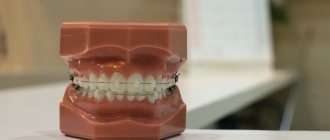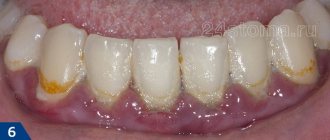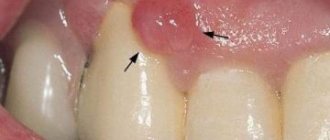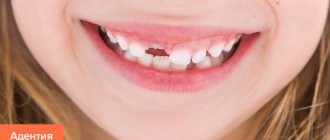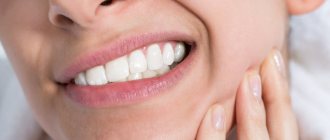A chipped tooth is one of the most common mechanical damage to the dentition; also, the breaking off of a part of a tooth can be caused by a decrease in the strength of dental tissues due to various diseases of the oral cavity. Decay of teeth, especially those located in the front part, reduces the aesthetics of a smile, so most often people try not to put off visiting the dentist. However, there are injuries that are not very noticeable at first, especially if they are not accompanied by pain, and if a tooth injury is left to chance, this can lead to unpleasant consequences.
Chipped front tooth
Dental tissue is the hardest surface in the entire body, consisting of 96% inorganic substances, 3% water and only 1% organic materials. Despite the fact that the composition of tooth enamel does not contain collagen, it contains other protein compounds, for example, enamelins and amelogenins. Dental tissue is wear-resistant and highly durable, and the top layer of enamel can reach 2.5 mm, but for all its advantages, it has a serious drawback - the inability to regenerate, so over time the tooth surface becomes thinner and there is a risk of chipping.
For modern dentistry, there is very little that is impossible, and repair of a chipped tooth can be done quickly, efficiently and effectively in our clinic, where the most highly qualified specialists and real luminaries of medicine work. And in order for our patients to be armed with information and ready for anything, we will tell you in detail about what causes a tooth fracture, what treatment methods exist and how to restore a chipped tooth.
Causes of dental injury
A large or barely noticeable gap in the teeth area spoils the entire appearance. To treat and restore a tooth, you need to know the main causes of dental injury. There are several of them.
1. Mostly, children receive mechanical injuries from a fall or bruise, when parents see, for example, that a front tooth has broken at the root.
2. Children's teeth are not yet strong enough to experience serious jaw load. Therefore, it is worth making sure that children do not get used to, for example, clenching their teeth tightly.
3. If half of the tooth crown is broken, it is due to a poor-quality filling.
4. The filling or inlay may pop out or break when it reaches the end of its service life.
5. Teeth with thinned enamel become a risk area.
6. Due to thinned enamel, the tooth may be destroyed due to carious formation.
7. The quality and properties of food also affect tooth decay.
Avoid giving children foods that are too hard or rough. Even seeds can cause a piece of a tooth to break off. To avoid all these unpleasant consequences, you will need to pay more attention to care, as well as the quality of food.
To strengthen tooth enamel, you need a sufficient amount of calcium in the body. To strengthen the structure, remineralization is required. The appearance of microcracks is due to the fact that the child receives food that is too contrasting. This affects the condition of the enamel, it becomes vulnerable. A weakened tooth may break at some point. This is the result of exposure to food and ingestion of hot and frozen drinks.
Features of artistic restoration using composites
First of all, the patient is promptly restored to the shape of the tooth using “available” materials in order to maintain the aesthetics of the smile area during treatment. The level of today's dental materials is so high that some patients are completely satisfied with such restoration and refuse further cooperation. Therefore, for not the most motivated clients, temporary modeling is performed without achieving complete color similarity.
Then a silicone impression is taken from the damaged and temporarily restored tooth, on the basis of which a so-called key will be made, which will allow the artistic part of the work to be completed with high quality.
To achieve an ideal resemblance, the dentist, even with a small chip, has to combine from 3-4 to 5-6 shades of the photopolymer composite. If you do this at random, the patient will not be very pleased with the result: the restored part will differ from natural tissue. The key helps to accurately maintain the relationship between all layers of material of different tones, so that the saturation, lightness and transparency of the restored and natural parts completely coincide.
Typology of dental trauma
If a piece of a tooth breaks, the fragments can trap the enamel when destroyed. In these cases, the tooth breaks open or closed, and the pulp may open. Tooth injuries are distinguished by the area of the fracture - at the root, on top, etc. In case of injury, when a piece may break off, the tooth is often displaced.
The nature of the damage depends on the size of the chipped part, for example, if a child’s upper wisdom tooth is half broken:
- minimal degree of injury;
- average degree of injury;
- severe degree of injury.
When a tooth is damaged, the enamel is often affected. This is a minimal type of injury when the internal layers are not affected. The opposite indicates the average severity of the tooth fracture. In such a situation, the damage touches the pulp and the nerve is affected.
Let's look at the main types of dental damage. This is important for understanding what to do if a piece of a tooth breaks off.
1. The tooth broke in the root zone . The child’s tooth root is not yet strong enough to be difficult to remove.
The greatest risk, as always, falls on the upper front incisors. In order to determine why a child’s baby tooth has broken off, modern diagnostics will be required. A tooth fracture in the root area is determined by a series of x-rays. It is detected, as a rule, with the appearance of characteristic sensations due to inflammation of the gums. Depending on the degree of root destruction, the pulp will be affected, and this already leads to more serious consequences.
2. If a front tooth breaks off, and it is a baby tooth . Most often, a small piece breaks off from a small tooth. This can happen for various reasons. The doctor will determine the degree of danger. If the crown under the root is broken, the tooth will have to be removed. When a tooth chips away from the root, cosmetic restoration can be used to solve the problem. Usually the dentist performs extensions.
Often a tooth is displaced or dislocated as a result of a side blow to the jaw. For example, a child hit something when falling or another child accidentally touched it, and your child’s front tooth broke off. As a result, gum swelling may occur. The entry of microbes into the wound leads to the loss of a tooth, even if it is a milk tooth. It can be restored, but to do this it must be preserved in warm milk or saline until the implantation procedure.
Should I save the piece that fell off?
If part of a tooth breaks off , if possible, you need to find it and take it with you to the appointment. If necessary, the doctor, using modern materials, can glue it back. By fixing a broken fragment, a tooth today can be restored not only to its natural appearance, but also to full functionality. This cannot always be achieved by creating an imitation, albeit an accurate one.
What if a baby tooth breaks off?
The fragment needs to be washed, put in milk, or, in extreme cases, just in water, and immediately go with the child to the clinic. You shouldn’t think that baby teeth will soon be replaced by permanent ones, so you can leave everything as is. If the child does not even complain of pain, an infection can penetrate into the exposed dentin. Sooner or later, inflammation will reach the pulp, and then the periodontium. This will cause a whole chain of further troubles.
In addition, the rudiments of permanent teeth form under the milk teeth, which can also be affected by injury. If the pediatric dentist determines that there is a direct threat to the bud, the baby tooth will most likely be removed.
Now let's consider another situation. A wisdom tooth chipped into the gums - what to do?
If a tooth breaks or falls out, do not treat the area with peroxide, alcohol, touch the wound, or brush with a toothbrush. In a situation where there is a suspicion of not just a broken tooth, but also a broken jaw, she needs to be provided with peace and immobilized. To do this, you will need to make a bandage passing through the top of the head.
Severe trauma to the jaw can lead to nosebleeds. In this case, it is necessary for the child to lower his head and place a cold compress on the bridge of his nose. At the same time as these actions, someone should call the doctor.
After identifying the nature of the damage in the hospital using an X-ray, it will be possible to determine how damaged the surrounding tissues are, whether there are dislocations or subluxations.
Three artistic restoration options
A partially destroyed front tooth is restored using direct and indirect methods: modeling it using modern composite materials and installing onlays and veneers.
- Minor damage can be repaired with composite fillings .
- In more serious cases, when dentin chips, not only a photocomposite, but also a pin or a special inlay are used to build up the crown. Working in pairs, they will restore functionality to the tooth, and it will not even need to be covered with an artificial crown.
- By installing veneers as an alternative to fillings on the front teeth , dentists do an excellent job with external chips. It is much easier to work with ceramic plates, primarily because of the ability to quickly and easily achieve complete similarity of the imitation with neighboring natural teeth.
Possible complications
Complex injuries can often have serious consequences, manifested in complications. It doesn’t matter which tooth was injured – the front incisor, the chewing tooth. After the examination, the doctor will decide how to save the child’s tooth. If you neglect the recommendations of a specialist, this can lead to more serious consequences, not to mention aesthetics.
Types of complications
1. Possibility of infection of the pulp area.
2. Increased tooth sensitivity.
3. The appearance of a bend in the tooth root.
4. Violation of occlusion.
5. Formation of cysts and granulomas.
You need to prepare for the fact that a damaged child’s tooth will begin to change the angle of development. And this leads to deformation not only of the damaged tooth, but also of its healthy neighbors. If it is necessary to remove a broken tooth, the space must be filled with an implant. If filling is not carried out, other teeth will begin to shift and move closer together, which leads to occlusion disorders - bite.
What are the dangers of dental injuries?
Tooth decay is associated with damage to internal tissues. If caries is not treated in time, damage to the pulp - the core of the tooth with the presence of nerves and blood vessels - will occur. And then – the inflammatory process. The child will begin to feel constant toothache and complain about his health. The inflammatory process will affect different areas. In children, pulp periodontitis develops due to inflammation. This is due to the fact that the roots of a child’s tooth develop and strengthen over a long period of time, so damage occurs faster.
What experts advise for prevention
As in the case of any other pathological conditions, it is always better to prevent unpleasant consequences than to later engage in long and costly, and sometimes quite painful, treatment. To reduce the risk of damage and destruction of children's primary incisors and molars, it is necessary from an early age to teach the child to take a responsible approach to oral care, brush his teeth every morning and evening, and follow all basic hygiene rules.
It is worth keeping a close eye on your baby while he is playing. Try to exclude all traumatic factors. Later, if the child begins to engage in traumatic sports, he should be given an individual protective mouthguard - this service is provided by many modern dentists.
It is worth keeping a close eye on your baby while he is playing.
But finally, in no case should you ignore any pathological changes in the oral cavity, even if there are only temporary baby incisors and molars. If there is a clear malocclusion, orthodontic treatment should be started promptly. If caries and inflammatory processes develop, immediately show the child to a specialist. Parents need to remember that any advanced dental diseases can easily damage the buds of permanent teeth, which will inevitably affect their condition and health in the future.
1Eradze E.P., Osipov G.A. Modern methods of treating acute dental trauma in children, 2001.
How to restore a damaged area?
A child with a chipped tooth should be taken to the dentist immediately. The doctor will fill the canals in the exposed pulp and remove the nerve bundle. In general, different methods and technologies are used today to restore and preserve teeth.
- For a broken tooth, dental crowns are used.
- The doctor can place veneers for children.
- When a tooth is broken or chipped, your doctor may place baby inlays.
The use of a crown is advisable when a tooth in the upper row of incisors is broken or when the chewing teeth are damaged. But at the same time, processing (grinding) is carried out on neighboring ones.
You can restore your front teeth thanks to thin onlays - veneers, which can be matched to the rest of your teeth. If a tooth is broken and cannot be restored, the doctor will clean the canals and install an inlay (implant).
With the help of intracanal pins, it is possible to restore a chipped tooth if the parents decided to save it. With this method of dentures, aesthetics are preserved as much as possible. The operation will not affect the bite or chewing function.
Prevention of tooth decay
We must try to avoid serious dental problems and prevent situations where a child could be injured or break a tooth. Parents should try to minimize all risks. To do this, it is enough to apply a few simple rules in practice.
For proper growth and development of bones and teeth, it is necessary to provide the child with complete, high-quality nutrition. Then the body will receive the entire complex of necessary micronutrients, vitamins, and substances.
When the baby has all his milk teeth, around the age of three, it would be good to give him more solid food. Various vegetables, fruits, and crackers are suitable for this. This way the child will become accustomed to more adult food, which will strengthen his teeth.
To maintain healthy teeth, you need to pay attention to the development of the child’s chewing muscles; for this, you should control the consistency of food.
It is important to teach your child to brush his teeth and instill the good habit of visiting the dentist periodically.
View prices
Making an appointment with a dentist




